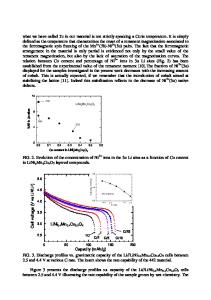Neutron diffraction and electrochemical studies of Li x Ni 1/3 Mn 1/3 Co 1/3 O 2
- PDF / 608,016 Bytes
- 6 Pages / 612 x 792 pts (letter) Page_size
- 56 Downloads / 322 Views
K11.10.1
Neutron diffraction and electrochemical studies of LixNi1/3Mn1/3Co1/3O2 Shih-Chieh Yin, Young-Ho Rho, Ian Swainson# and Linda F. Nazar* *Department of Chemistry, University of Waterloo, Waterloo, Ontario, Canada. N2L 3G1 # Chalk River Laboratories, Chalk River, Ontario, Canada. K0J 1J0 ABSTRACT Amongst solid solutions of the Li-Ni-Mn-Co-O series, LiNi1/3Mn1/3Co1/3O2 has received much attention owing to its high capacity and thermal stability. A major issue in these ordered rock salt structures is the irreversibility on the first cycle, and degree of Li+/Ni2+ cation disorder which inhibits the rate capability. To examine these factors, different synthesis methods were employed which led to LiNi1/3Mn1/3Co1/3O2 that exhibited varying degrees of cation disorder. Neutron diffraction studies were carried out on samples (LixNi1/3Mn1/3Co1/3O2, x = 1.00 Æ 0.04) prepared by chemical oxidation. The studies reveal that the extent of Ni2+/Li+ disorder between the 3b and 3a sites was preserved on Li extraction and re-insertion. Complete extraction of lithium to form the O1 phase was achieved in some materials. However, reformation of the O3 phase on chemical relithiation does not occur in these cases, whereas materials that only partly convert to the Ol phase exhibit complete conversion back to the O3 phase on relithiation. The differences are attributed to lithium site occupancy/stoichiometry and crystallite size effects. INTRODUCTION The success of the layered LiCoO2 cathode coupled with a carbonaceous anode has advanced rechargeable batteries to a new era. Since the first studies by Goodenough1 and its implementation by SONY, this cell has dominated the market due to its high energy density coupled with good cycle stability. However, the high cost of cobalt has driven research to replace it, in whole or in part, with transition metals such as Ni, Mn or Cr to meet future demands for large scale rechargeable batteries for hybrid vehicles. LiNiO22,3 suffers stability issues and impeded Li transport, although partial Co or Al substitution improves the cyclability significantly. Structures based on a solid solution of multiple transition metals include early work on LiCo1-xNixO2 (0≤x≤1),1,4 and more recent materials such as LiCo1/3Ni1/3Mn1/3O2,5 LiNi1/2Mn1/2O2,6 Li[NixCo1-2xMnx]O2 (0≤x≤1/2),7 and Li3CrMnO5 (Li1.2Cr0.4Mn0.4O2).8 Amongst them, LiNi1/2Mn1/2O2 and LiCo1/3Ni1/3Mn1/3O2 were reported to have comparable or higher capacity than LiCoO2 with better thermal stability.9 Here, various lithium precursors were employed to prepare the title compound. The materials exhibit different degrees of cation disorder, and their electrochemistry is evaluated. The disorder of delithiated samples were also studied as well as the end product, the O1 phase,10 which is composed of one MO2 sheet in the unit cell, and vacancies in the octahedral site.11 A fully delithiated O1 phase could be readily obtained by control of precursor composition and stoichiometry. The electrochemistry of the title compound is discussed with respect to the fo
Data Loading...











